上海版牛津英语2a教案全册
- 格式:doc
- 大小:224.00 KB
- 文档页数:36
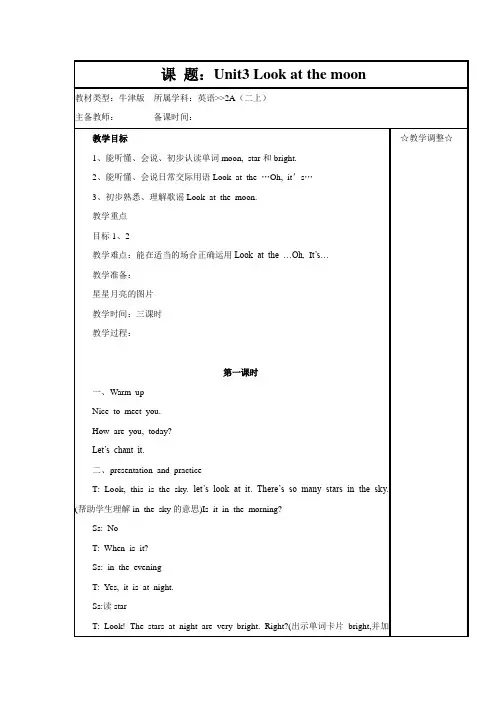
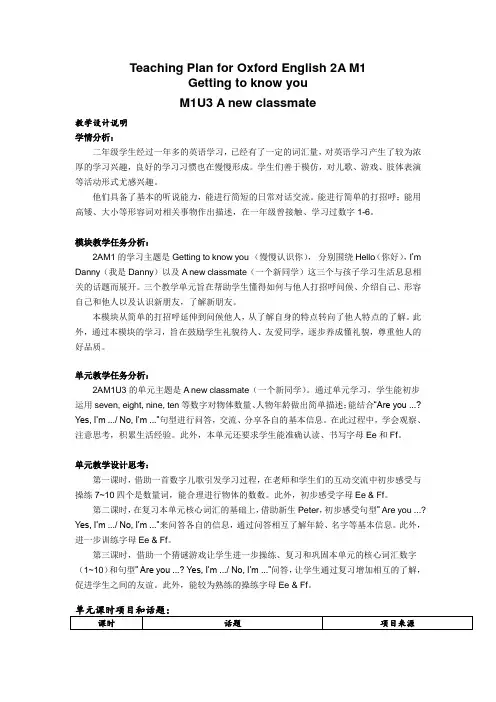
Teaching Plan for Oxford English 2A M1Getting to know youM1U3 A new classmate教学设计说明学情分析:二年级学生经过一年多的英语学习,已经有了一定的词汇量,对英语学习产生了较为浓厚的学习兴趣,良好的学习习惯也在慢慢形成。
学生们善于模仿,对儿歌、游戏、肢体表演等活动形式尤感兴趣。
他们具备了基本的听说能力,能进行简短的日常对话交流。
能进行简单的打招呼;能用高矮、大小等形容词对相关事物作出描述,在一年级曾接触、学习过数字1-6。
模块教学任务分析:2AM1的学习主题是Getting to know you (慢慢认识你),分别围绕Hello(你好),I’m Danny(我是Danny)以及A new classmate(一个新同学)这三个与孩子学习生活息息相关的话题而展开。
三个教学单元旨在帮助学生懂得如何与他人打招呼问候、介绍自己、形容自己和他人以及认识新朋友,了解新朋友。
本模块从简单的打招呼延伸到问候他人,从了解自身的特点转向了他人特点的了解。
此外,通过本模块的学习,旨在鼓励学生礼貌待人、友爱同学,逐步养成懂礼貌,尊重他人的好品质。
单元教学任务分析:2AM1U3的单元主题是A new classmate(一个新同学)。
通过单元学习,学生能初步运用seven, eight, nine, ten等数字对物体数量、人物年龄做出简单描述;能结合“Are you ...? Yes, I’m .../ No, I’m ...”句型进行问答,交流、分享各自的基本信息。
在此过程中,学会观察、注意思考,积累生活经验。
此外,本单元还要求学生能准确认读、书写字母Ee和Ff。
单元教学设计思考:第一课时,借助一首数字儿歌引发学习过程,在老师和学生们的互动交流中初步感受与操练7~10四个是数量词,能合理进行物体的数数。
此外,初步感受字母Ee & Ff。
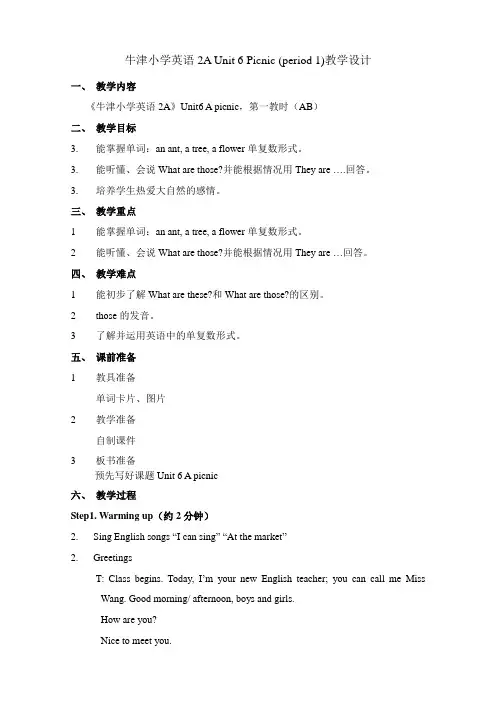
牛津小学英语2A Unit 6 Picnic (period 1)教学设计一、教学内容《牛津小学英语2A》Unit6 A picnic,第一教时(AB)二、教学目标3.能掌握单词:an ant, a tree, a flower单复数形式。
3.能听懂、会说What are those?并能根据情况用They are ….回答。
3.培养学生热爱大自然的感情。
三、教学重点1能掌握单词:an ant, a tree, a flower单复数形式。
2能听懂、会说What are those?并能根据情况用They are …回答。
四、教学难点1能初步了解What are these?和What are those?的区别。
2those的发音。
3了解并运用英语中的单复数形式。
五、课前准备1教具准备单词卡片、图片2教学准备自制课件3板书准备预先写好课题Unit 6 A picnic六、教学过程Step1. Warming up(约2分钟)2.Sing English songs “I can sing”“At the market”2.GreetingsT: Class begins. Today, I’m your new English teacher; you can call me Miss Wang. Good morning/ afternoon, boys and girls.How are you?Nice to meet you.I want to make friends with you. So I want to know something about you.I can …. What can you do? I like mangoes. What do you like?(sing, dance, run, jump,swim, skate, play yoyo, play chess)T: Now, I know you, do you want to know me, you can ask me some questions, like “What can you do? / What do you like?I think we are friends now.Look at the star.Ss: It’s bright/ small.T: Do you remember the rhyme “a star”?Let’s say it together.T: What’s this?Ss: It’s a tree.教学:a treeStep2. Presentation and practice(约18分钟)1. (出示公园画面)What’s this?Ss: It’s a park.T: It is fine today. Let’s go to the park.Ss: OK.T: Wow, what a beautiful park! (指向一群小鸟)What are these?引生答:They are birds.Repeat “They are ….”并板书。
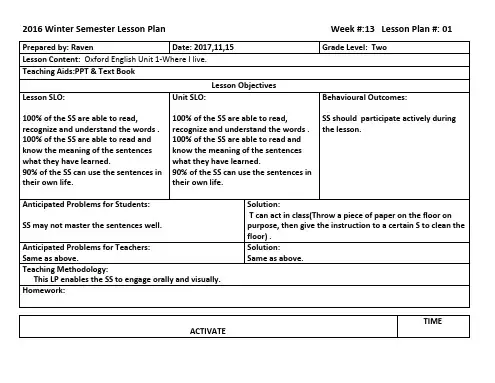
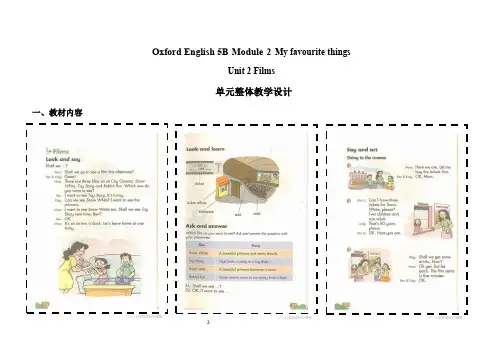
Oxford English 5B Module 2My favourite thingsUnit 2 Films单元整体教学设计一、教材内容二、单元规划1. 单元内容分析单元主题:Films2. 单元语言知识内容要求分析3.学情分析4.单元学习目标●知识与技能1. 能识别国际音标/m/, /n/, /ŋ/,正确朗读含有该音标的单词。
2. 能在语境中知晓并理解ticket, ticket office, entrance, exit, seat等有关电影院的词汇,能听、读和规范书写。
同时能借助语境,知晓并理解描述电影院的语篇。
3. 能在语境中运用句型Shall we …?询问,并进行正确的应答。
4. 能在语境中,理解故事内容,获取相关信息,运用本单元的所学词句围绕电影主题进行表达。
●思维与策略注重语言输入输出的量和度的意识,能在课堂学习中,通过问答,讲述,模仿,思考,小组合作等方式,完成学习任务。
●文化与情感初步了解电影文化,感受观影的快乐。
5. 单元学习任务三、单元学习过程(一)第一课时学习过程1. 话题:The cinema near my home2. 学习任务:读懂关于电影院的信息和语篇。
3. 学习目标:●语言理解(1)能识别国际音标/m/和/n/,并能朗读含有该音素的单词(2)能在语境中理解核心词汇:ticket, ticket office, entrance, exit●语言表达(1)通过文本视听、跟读模仿、看图说话等形式学习ticket, ticket office, entrance, exit, seat等有关电影院的词汇,能听、读和规范书写;(2)通过文本朗读、信息寻找、问答交流等形式读懂关于电影院的信息和语篇●思维特征(1)通过倾听、模仿、跟读等形式学习语音。
(2)通过看图听音、跟读模仿、问答交流、看图说话等形式学习本单元核心词汇。
●文化情感了解电影院相关的院设施与观影规则●学习策略(1)借助媒体、图片、照片等直观媒介学习对话。
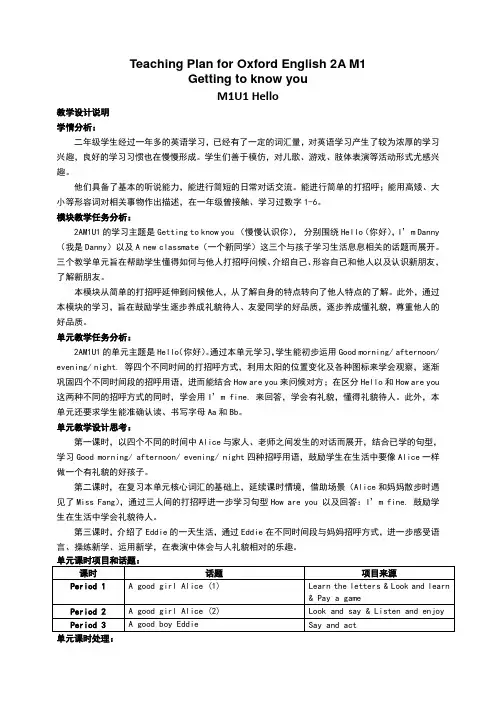
Teaching Plan for Oxford English 2A M1Getting to know youM1U1 Hello教学设计说明学情分析:二年级学生经过一年多的英语学习,已经有了一定的词汇量,对英语学习产生了较为浓厚的学习兴趣,良好的学习习惯也在慢慢形成。
学生们善于模仿,对儿歌、游戏、肢体表演等活动形式尤感兴趣。
他们具备了基本的听说能力,能进行简短的日常对话交流。
能进行简单的打招呼;能用高矮、大小等形容词对相关事物作出描述,在一年级曾接触、学习过数字1-6。
模块教学任务分析:2AM1U1的学习主题是Getting to know you (慢慢认识你),分别围绕Hello(你好),I’m Danny (我是Danny)以及A new classmate(一个新同学)这三个与孩子学习生活息息相关的话题而展开。
三个教学单元旨在帮助学生懂得如何与他人打招呼问候、介绍自己、形容自己和他人以及认识新朋友,了解新朋友。
本模块从简单的打招呼延伸到问候他人,从了解自身的特点转向了他人特点的了解。
此外,通过本模块的学习,旨在鼓励学生逐步养成礼貌待人、友爱同学的好品质,逐步养成懂礼貌,尊重他人的好品质。
单元教学任务分析:2AM1U1的单元主题是Hello(你好)。
通过本单元学习,学生能初步运用Good morning/ afternoon/ evening/ night. 等四个不同时间的打招呼方式,利用太阳的位置变化及各种图标来学会观察,逐渐巩固四个不同时间段的招呼用语,进而能结合How are you来问候对方;在区分Hello和How are you 这两种不同的招呼方式的同时,学会用I’m fine. 来回答,学会有礼貌,懂得礼貌待人。
此外,本单元还要求学生能准确认读、书写字母Aa和Bb。
单元教学设计思考:第一课时,以四个不同的时间中Alice与家人、老师之间发生的对话而展开,结合已学的句型,学习Good morning/ afternoon/ evening/ night四种招呼用语,鼓励学生在生活中要像Alice一样做一个有礼貌的好孩子。
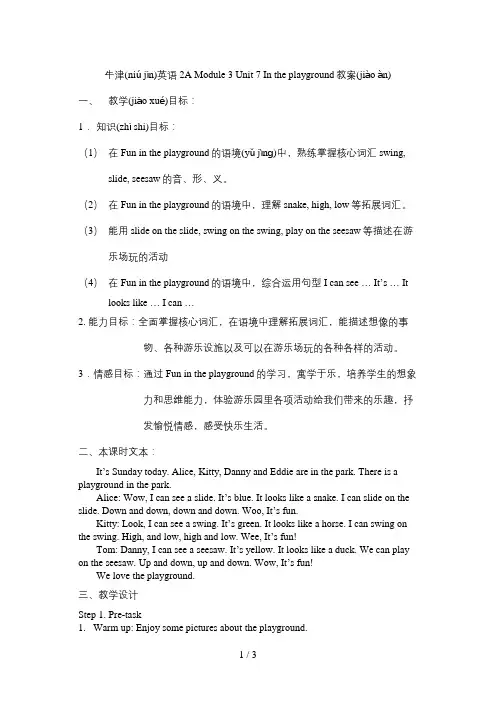
牛津(niú jīn)英语2A Module 3 Unit 7 In the playground教案(jiào àn)一、教学(jiāo xué)目标:1.知识(zhī shi)目标:(1)在Fun in the playground的语境(yǔ jìnɡ)中,熟练掌握核心词汇swing, slide, seesaw的音、形、义。
(2)在Fun in the playground的语境中,理解snake, high, low等拓展词汇。
(3)能用slide on the slide, swing on the swing, play on the seesaw等描述在游乐场玩的活动(4)在Fun in the playground的语境中,综合运用句型I can see … It’s … It looks like … I can …2. 能力目标:全面掌握核心词汇,在语境中理解拓展词汇,能描述想像的事物、各种游乐设施以及可以在游乐场玩的各种各样的活动。
3.情感目标:通过Fun in the playground的学习,寓学于乐,培养学生的想象力和思维能力,体验游乐园里各项活动给我们带来的乐趣,抒发愉悦情感,感受快乐生活。
二、本课时文本:It’s Sunday today. Alice, Kitty, Danny and Eddie are in the park. There is a playground in the park.Alice: Wow, I can see a slide. It’s blue. It looks like a snake. I can slide on the slide. Down and down, down and down. Woo, It’s fun.Kitty: Look, I can see a swing. It’s green. It looks like a horse. I can swing on the swing. High, and low, high and low. Wee, It’s fun!Tom: Danny, I can see a seesaw. It’s yellow. It looks like a duck. We can play on the seesaw. Up and down, up and down. Wow, It’s fun!We love the playground.三、教学设计Step 1. Pre-task1.Warm up: Enjoy some pictures about the playground.2.Revision: Ask and answer: What can you see? What color is it?(设计意图:通过各种有趣的有关操场的图片,创设情境回忆已学主题,通过对话复习旧知,为下一步的学习做好铺垫,导入本课的语境)Step 2. While-task1.Fun in the playground(1)Listen to the text.(2)Ask and answer.(设计意图:创设情景呈现文本,让学生整体感知本课时的教学内容)2.Fun with the slide.(1)Listen the 1st paragraph.(2)Ask and answer: Which slide does Alice play?(3)Play a shadow game to practice: It looks like …(4)Read and answer(5)Read and act(设计意图:运用(yùnyòng)TPR教学法引导学生有节奏地边做动作边说句子。
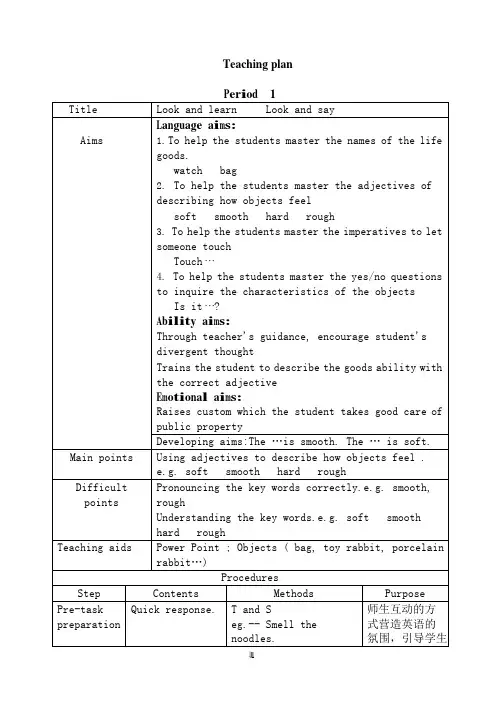
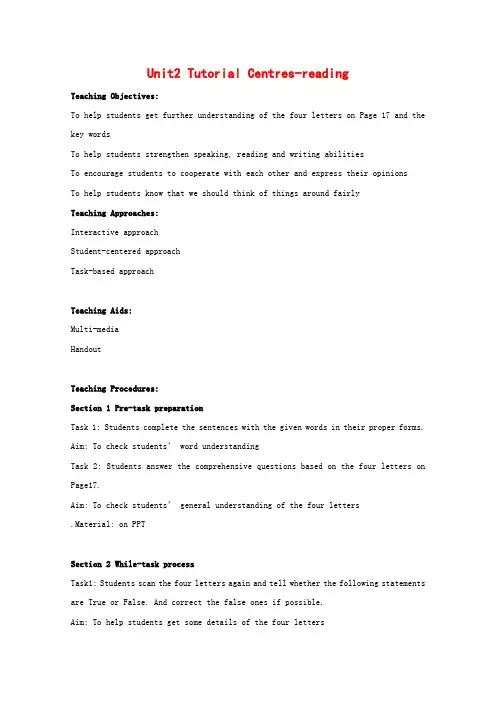
Unit2 Tutorial Centres-readingTeaching Objectives:To help students get further understanding of the four letters on Page 17 and the key wordsTo help students strengthen speaking, reading and writing abilitiesTo encourage students to cooperate with each other and express their opinionsTo help students know that we should think of things around fairlyTeaching Approaches:Interactive approachStudent-centered approachTask-based approachTeaching Aids:Multi-mediaHandoutTeaching Procedures:Section 1 Pre-task preparationTask 1: Students complete the sentences with the given words in their proper forms. Aim: To check students’ word understandingTask 2: Students answer the comprehensive questions based on the four letters on Page17.Aim: To chec k students’ general understanding of the four letters.Material: on PPTSection 2 While-task processTask1: Students scan the four letters again and tell whether the following statements are True or False. And correct the false ones if possible.Aim: To help students get some details of the four lettersTask2: Students read the letters and try to find some useful information from each letter.Aim: To help students get further understandings of each letter and have an idea of an argumentative letterMaterials: Handout & PPT.Section 3 Post-task activityTask: Students fill in the blanks of the conclusion of the letters.Aim: To help students conclude the four letters and know the use of the key words and phrasesMaterial: on PPTSection 4Assignments1. Read the four letters on Page 17 carefully and underline the difficult points.2. Try to put the following sentences into English:(1) 我在另外一家补习中心报名了。
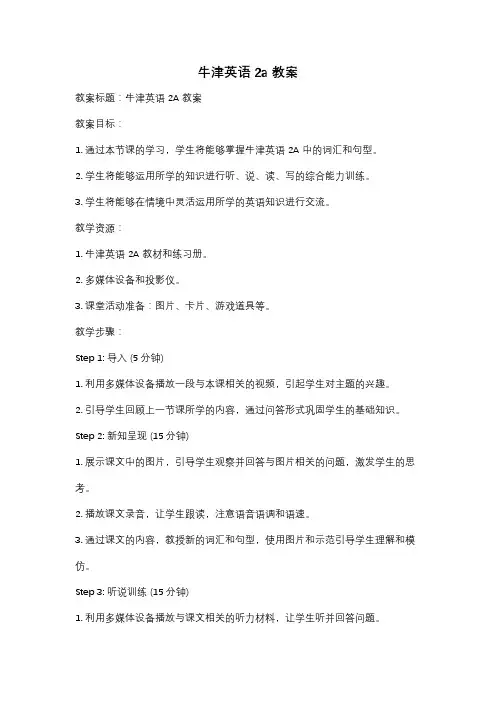
牛津英语2a教案教案标题:牛津英语 2A 教案教案目标:1. 通过本节课的学习,学生将能够掌握牛津英语 2A 中的词汇和句型。
2. 学生将能够运用所学的知识进行听、说、读、写的综合能力训练。
3. 学生将能够在情境中灵活运用所学的英语知识进行交流。
教学资源:1. 牛津英语 2A 教材和练习册。
2. 多媒体设备和投影仪。
3. 课堂活动准备:图片、卡片、游戏道具等。
教学步骤:Step 1: 导入 (5分钟)1. 利用多媒体设备播放一段与本课相关的视频,引起学生对主题的兴趣。
2. 引导学生回顾上一节课所学的内容,通过问答形式巩固学生的基础知识。
Step 2: 新知呈现 (15分钟)1. 展示课文中的图片,引导学生观察并回答与图片相关的问题,激发学生的思考。
2. 播放课文录音,让学生跟读,注意语音语调和语速。
3. 通过课文的内容,教授新的词汇和句型,使用图片和示范引导学生理解和模仿。
Step 3: 听说训练 (15分钟)1. 利用多媒体设备播放与课文相关的听力材料,让学生听并回答问题。
2. 进行口语训练,以小组形式进行对话练习,学生可以使用所学的句型和词汇进行交流。
Step 4: 读写训练 (15分钟)1. 学生根据课文内容,进行朗读训练,注意语音语调和流利度。
2. 利用多媒体设备播放与课文相关的阅读材料,让学生进行阅读理解练习。
3. 引导学生进行写作训练,要求他们根据所学的词汇和句型,写一篇关于自己的介绍。
Step 5: 温故知新 (10分钟)1. 利用游戏道具或卡片进行复习,让学生回忆本节课所学的内容。
2. 进行简短的问答环节,检查学生对本节课内容的掌握情况。
Step 6: 作业布置 (5分钟)1. 布置课后练习册的相关习题,巩固所学的知识。
2. 鼓励学生自主学习,提供相关的学习资源和网站链接。
教学反思:在教案中,通过多种教学手段和资源的运用,帮助学生全面掌握牛津英语 2A中的词汇和句型。
同时,通过听、说、读、写的综合能力训练,培养学生的英语交际能力。
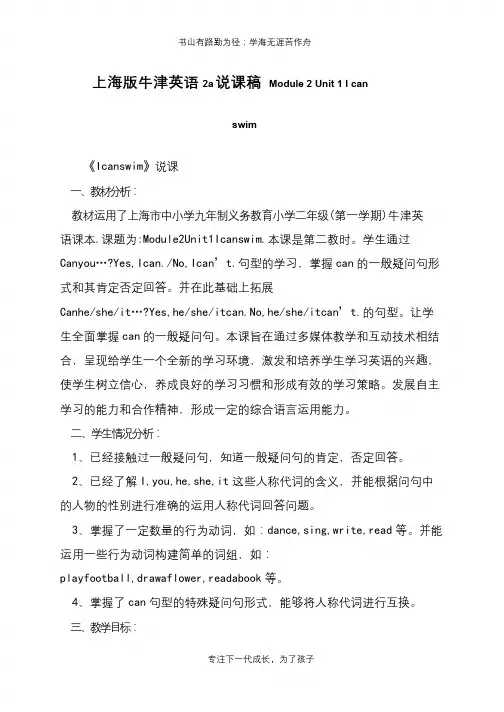
上海版牛津英语2a 说课稿Module 2 Unit 1 I canswim《Icanswim》说课一、教材分析:教材运用了上海市中小学九年制义务教育小学二年级(第一学期)牛津英语课本.课题为:Module2Unit1Icanswim.本课是第二教时。
学生通过Canyou…?Yes,Ican./No,Ican’t.句型的学习,掌握can的一般疑问句形式和其肯定否定回答。
并在此基础上拓展Canhe/she/it…?Yes,he/she/itcan.No,he/she/itcan’t.的句型。
让学生全面掌握can的一般疑问句。
本课旨在通过多媒体教学和互动技术相结合,呈现给学生一个全新的学习环境,激发和培养学生学习英语的兴趣,使学生树立信心,养成良好的学习习惯和形成有效的学习策略。
发展自主学习的能力和合作精神,形成一定的综合语言运用能力。
二、学生情况分析:1、已经接触过一般疑问句,知道一般疑问句的肯定,否定回答。
2、已经了解I,you,he,she,it这些人称代词的含义,并能根据问句中的人物的性别进行准确的运用人称代词回答问题。
3、掌握了一定数量的行为动词,如:dance,sing,write,read等。
并能运用一些行为动词构建简单的词组,如:playfootball,drawaflower,readabook等。
4、掌握了can句型的特殊疑问句形式,能够将人称代词进行互换。
三、教学目标:根据布卢姆的教育目标分类学,我将教学目标分为以下三类:1、认知目标:1)、掌握Canyou…?Yes,Ican./No,Ican’t.句型。
2)、复习行为动词和含有行为动词的词组。
3)、复习can的特殊疑问句。
2、技能目标:1)、能运用can的一般疑问句进行相互问答。
2)、能将不同的人称代词放入can的一般疑问句中进行互换,并准确的回答。
3)、能根据所学的知识点进行错位理解。
3、情感目标:1)、体会学习的乐趣,在竞争中获得成功的满足感。
Teaching Plan for Oxford English 2A M2Me, my family and friendsU1 I can swim教学设计说明学情分析:二年级学生经过一年多的英语学习,已经有了一定的词汇量,对英语学习产生了较为浓厚的学习兴趣,良好的学习习惯也在慢慢形成。
学生们善于模仿,对儿歌、游戏、肢体表演等活动形式尤感兴趣。
他们具备了基本的听说能力,能进行简短的日常对话交流。
能进行简单的打招呼;能用高矮、大小等形容词对相关事物作出描述,能用can句型进行简单问答与描述,涉及到的相关动词有read, draw, sing and dance等。
模块教学任务分析:2AM2的学习主题是Me, my family and friends (我和我的家庭与朋友),分别围绕I can swim(我会游泳),That’s my family(那是我的家庭)以及My hair is short(我的头发是短的)这三个与孩子家庭、学习生活息息相关的话题而展开。
三个教学单元旨在帮助学生认识自我,感受能力;在进一步认识家庭成员的基础上,进行合理描述;在了解更多的人体部位的基础上,学会观察、学会比较、尝试描述与分享。
本模块学习的内容较为宽泛,从了解自我延伸到了对家人的了解,从关注自身的能力转向了对家人的特征关注;在观察、比较与梳理中,学会比对、学会思考,在分享各自能力的同时,感受亲情、体验家庭的温馨。
单元教学任务分析:2AM2U1的单元主题是I can swim(我会游泳)。
通过本单元学习,学生能初步运用run, write, swim和fly等四个动作;学习、运用Can you …? Yes, I can./ No, I can’t. 来分享各自的能力,体会各自的才能。
此外,本单元还要求学生能准确认读、书写字母Gg和Hh。
单元教学设计思考:第一课时,某一天,Tom猫遇到4个动物朋友(fish、bird, monkey和dog),和他们分别展开了对话;在对话中,初步感知、学习run, write, swim和fly等四个动词,了解了can 与can’t的不同。
U n i t4C l e a n t h e t a b l e,p l e a s e.第一课时一、教学内容《牛津小学英语2A》第四单元,第一课时(Learntosay,Lookandlearn)。
二、教学目标1.能初步听懂、会说单词adoor,awindow,adesk,atable,achair。
2.能听懂、会说句型Cleanthe…,please.及其回答Allright.3.培养学生养成良好的卫生习惯以及热爱劳动的意识。
三、教学重点1.能初步听懂、会说单词adoor,awindow,adesk,atable,achair。
2.能听懂、会说句型Cleanthe…,please.并能用Allright.回答。
四、教学难点能在情景中正确运用Cleanthe…,please.请求他人完成特定动作,语音语调正确。
五、课前准备1.教具准备1)本单元B部分单词图片及教室图片。
2)句子卡片。
3)自制课件。
4)游戏卡片。
2.板书准备事先写好课题Unit4。
六、A.Warmingup(约3分钟):<Cleanthechair>:Oh,it’scold/hot…Close/Openthedoor,please.Close/Openthewindow,please.S:Allright/OK.T:Thankyou.B.Presentationandpractice(约15分钟):adoor,awindow,adesk,achair(重点为后两个单词)T:Now,let’,I’’Ss:Yes,it’sverynice.(帮助学会理解classroom)T:Boysandgirls,lookatourclassroom.Ss:It’sbright/big.T:Yes,it’(手指门)Oh,adoor.Ss:(手指窗)Awindow.用同样的方法学习adesk,achair教师出示图片及单词卡片,领读、齐读、个别读。
牛津小学英语2a教案教案标题:牛津小学英语2a教案教学目标:1. 学习掌握基本的英语词汇和句型。
2. 培养学生的听、说、读、写的综合能力。
3. 培养学生的合作和沟通能力。
教学准备:1. 教材:《牛津小学英语2A》2. 教具:黑板、彩色粉笔、教学PPT、音乐、图片、实物等。
教学过程:Step 1: Warm-up (热身活动) (10分钟)教师可以使用教学PPT或音乐等方式引导学生进行热身活动,如唱一首英文歌曲或说一些简单的英文口号,让学生活跃起来,进入英语学习的氛围。
Step 2: Presentation (呈现) (20分钟)1. 教师可以使用图片、实物等教具,呈现新学的词汇,如动物、水果、颜色等。
并引导学生进行观察和描述,帮助他们理解和记忆新词汇。
2. 教师可以使用教材上的图片和示例对话,引导学生学习新的句型和表达方式,并通过多次模仿和练习,帮助他们掌握。
Step 3: Practice (练习) (30分钟)1. 教师可以设计一些基础的听力练习,如听录音,找出正确的单词或图片等。
通过听力练习,培养学生的听力理解能力。
2. 教师可以设计一些口语练习,如小组活动,让学生两两组队进行对话练习,加强他们的口语表达和交流能力。
3. 教师可以设计一些阅读和写作练习,如让学生阅读课本中的短文,并回答相关问题;或让学生根据所学内容,写一篇小短文等。
Step 4: Consolidation (巩固) (20分钟)1. 教师可以使用教材上的练习题,让学生进行复习和巩固。
2. 教师可以设计一些游戏活动,如英语单词卡片游戏、角色扮演等,让学生在游戏中巩固所学的知识。
Step 5: Assessment (评估) (10分钟)教师可以设计一些简单的评估题目,检查学生对所学内容的理解和掌握程度。
可以使用选择题、填空题、配对题等形式。
Step 6: Wrap-up (总结) (10分钟)教师可以对本节课的学习内容进行总结,并鼓励学生积极参与下节课的学习。
Unit 1 Where I Live Teaching aids: A. Words : letters Aa --Bb , bin , park , road , building , Shanghai B. Structures : I live in …. I love …. I see …. That’s … C. Functions : Give simple instructions; Refer to specific classroom objects.
Material: 1. Student's Book 2A page 2--6 2. Cassette 1A and a cassette player 3. Wallcharts 4. Photograph page 1 5. Alphabet Cards
Teaching times: 5 times
Learning targets: A. Basic aims: 1. Be able to identify the letters Aa -- Bb 2. Be able to give simple instructions 3. Be able to use the simple present tense to indicate facts 4. Be able to "point to your home" 5. Read the rhyme B. Further aims: 1. 2.Practise saying a new rhyme substituting 'Shanghai' with another places Language focus: 1. Using the definite article to refer to specific classroom objects 2. Using the simple present tense to express interests and preferences 3. Learning the words: bin , park , road , building , Shanghai
Period 1 Teaching focus: Using imperatives to give simple instructions Using the definite article to refer to specific classroom objects
Teaching steps: Students activities Teaching activities Teaching starlegry Media
Pre-task preparation:
A: Point to a desk point to their own desk and say 'desk' students to follow : 'This is a classroom. We are in the classroom now. ' While-task procedure Look Performs the action and repeats the command The student performs the action The student performs the action. and say ' dsek '. Encourage the class to point to their own desk and say ' desk ' B: Gesture with arm to indicate the classroom and say 'This is a classroom. We are in the classroom now. ' (Say the word 'classroom' slowly and encourage students to follow) C: T :'Our classroom is nice. We must help to keep it clean.' A: T say 'Clean the desk.' And wipe a desk with a rag B: Invite a more able student to come to the front. Give the rag to him/her and say 'Clean the desk, please. ' C: Invite more able student to come to the front. Let the more able student give the command and others do the action. (Repeat with several groups of students.) D: Clean the classroom by sweeping the floor. Let the more able student to come up coaching coaching coaching cooperative learning Show 'Let's act' The students repeat and mime the actions. Post-task activities One student give the commands and the other mime the actions. Change roles Look Vote for the best pair Homework Read the ' Let' act ' after the cassette and say the command ' Sweep the floor, please. ' (Repeat step 3) E: Open the book to page 2. Play the cassette tape. Let the students listen to the instructions 'Clean the desk, please.' and ' Sweep the floor, please. ' Ask students to repeat and mime the actions. A: Divide students into pair. Have one student give the commands and the other mime the actions. Then let them change roles. B: Invite pairs of students to act out the dialogue to the class. cooperative learning book cassette
Workbook Period 2 Teaching focus: Using the simple present tense to indicate facts Using the simple present tense to express interests and preferences
Teaching steps: Students activities Teaching activities Teaching starlegry Media
Pre-task preparation:
Say the word ' Shanghai '
While-task procedure
Look and listen
A: Ask the students Where do you all live ? Show a picture of Shanghai (Say the word ' Shanghai ' slowly) T: That ' s right . We all live in Shanghai . Shanghai is our home . A: Put up the wallchart for page 3. Tell a story something like this : Sam and his father went for a walk on Sunday. After a while they sat down to rest and watched the ferries go by. They could see the Oriental Pearl Tower and a lot of tall buildings. Can you recongnize any? Sitting on the bench next to them were some tourists(a woman and her son). The boy asked Sam where he lived and Sam replied ' I live in Shanghai.' The boy said ' I love Shanghai.' Sam was coaching coaching Show a picture of Shanghai
Wallchart for page 3 The students talk about and answer the questions The students to copy ' I live in Shanghai. ' The students repeat ' I love Sally. ' Repeat Get student to say after pleased. Children, do you love Shanghai? If you do, you must help to keep it clean. Do not litter. Throw all rubbish into the bin. Can you find a bin in this picture? (Point to it) B: Ask questions such as the following: Where does Sam live? Where do you live? Dose Sam love Shanghai? Do you love Shanghai? What is this?(point to a bin and a building respectively) C: Hold up a stamped envelope and say ' My friend in Canada sent this to me. She had to write ' Shanghai ' on it because Ilive in Shanghai. Say ' I live in Shanghai. ' and ask students to copy you. D: Hug a toy bear and say ' This is my bear. Her name is Sally. I love Sally. ' Show the picture of Shanghai again. Hug it and say ' I love Shanghai. ' cooperative learning modeling